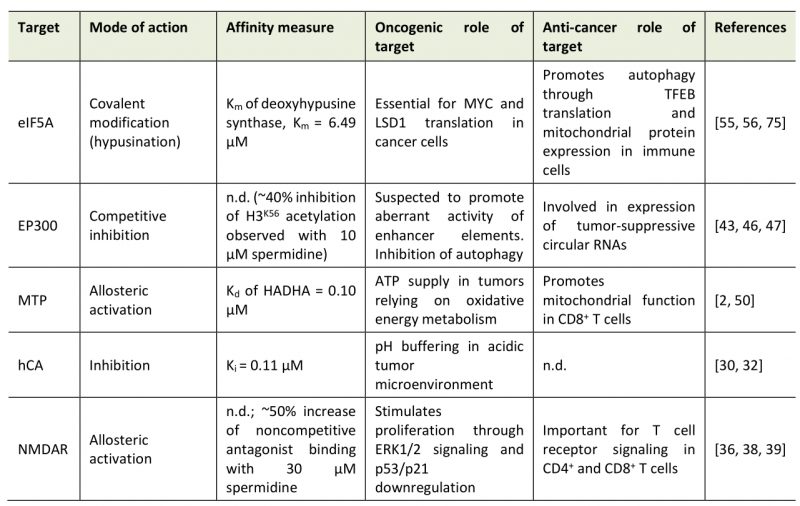Back to article: Molecular targets of spermidine: implications for cancer suppression
Table 1. Direct molecular targets of spermidine.
2. Al-Habsi M, Chamoto K, Matsumoto K, Nomura N, Zhang B, Sugiura Y, Sonomura K, Maharani A, Nakajima Y, Wu Y, Nomura Y, Menzies R, Tajima M, Kitaoka K, Haku Y, Delghandi S, Yurimoto K, Matsuda F, Iwata S, Ogura T, Fagarasan S, Honjo T (2022). Spermidine activates mitochondrial trifunctional protein and improves antitumor immunity in mice. Science 378(6618): eabj3510. 10.1126/science.abj3510
30. Davis RA, Vullo D, Supuran CT, Poulsen SA (2014). Natural product polyamines that inhibit human carbonic anhydrases. BioMed Res Int 2014: 374079. 10.1155/2014/374079
32. Chiche J, Ilc K, Laferrière J, Trottier E, Dayan F, Mazure NM, Brahimi-Horn MC, Pouysségur J (2009). Hypoxia-Inducible Carbonic Anhydrase IX and XII Promote Tumor Cell Growth by Counteracting Acidosis through the Regulation of the Intracellular pH. Cancer Res 69(1): 358–368. 10.1158/0008-5472.CAN-08-2470
36. Subramaniam S, O'Connor MJ, Masukawa LM, McGonigle P (1994). Polyamine Effects on the NMDA Receptor in Human Brain. Exp Neurol 130(2): 323–330. 10.1006/exnr.1994.1210
38. Stepulak A, Sifringer M, Rzeski W, Endesfelder S, Gratopp A, Pohl EE, Bittigau P, Felderhoff-Mueser U, Kaindl AM, Bührer C, Hansen HH, Stryjecka-Zimmer M, Turski L, Ikonomidou C (2005). NMDA antagonist inhibits the extracellular signal-regulated kinase pathway and suppresses cancer growth. Proc Natl Acad Sci U S A 102(43): 15605–15610. 10.1073/pnas.0507679102
39. Orihara K, Odemuyiwa SO, Stefura WP, Ilarraza R, HayGlass KT, Moqbel R (2018). Neurotransmitter signalling via NMDA receptors leads to decreased T helper type 1-like and enhanced T helper type 2-like immune balance in humans. Immunology 153(3): 368–379. 10.1111/imm.12846
43. Pietrocola F, Lachkar S, Enot DP, Niso-Santano M, Bravo-San Pedro JM, Sica V, Izzo V, Maiuri MC, Madeo F, Mariño G, Kroemer G (2015). Spermidine induces autophagy by inhibiting the acetyltransferase EP300. Cell Death Differ 22(3): 509–516. 10.1038/cdd.2014.215
46. Ding N, You AB, Yang H, Hu GS, Lai CP, Liu W, Ye F (2023). A Tumor-suppressive Molecular Axis EP300/circRERE/miR-6837-3p/MAVS Activates Type I IFN Pathway and Antitumor Immunity to Suppress Colorectal Cancer. Clin Cancer Res 29(11): 2095–2109. 10.1158/1078-0432.CCR-22-3836
47. Pan F, Iwasaki M, Wu W, Jiang Y, Yang X, Zhu L, Zhao Z, Cleary ML (2023). Enhancer remodeling drives MLL oncogene-dependent transcriptional dysregulation in leukemia stem cells. Blood Adv 7(11): 2504–2519. 10.1182/bloodadvances.2022008787
50. Amoedo ND, Sarlak S, Obre E, Esteves P, Bégueret H, Kieffer Y, Rousseau B, Dupis A, Izotte J, Bellance N, Dard L, Redonnet-Vernhet I, Punzi G, Rodrigues MF, Dumon E, Mafhouf W, Guyonnet-Dupérat V, Gales L, Palama T, Bellvert F, Dugot-Senan N, Claverol S, Baste JM, Lacombe D, Rezvani HR, Pierri CL, Mechta-Grigoriou F, Thumerel M, Rossignol R (2021). Targeting the mitochondrial trifunctional protein restrains tumor growth in oxidative lung carcinomas. J Clin Invest 131(1): e133081, 133081. 10.1172/JCI133081
55. Coni S, Serrao SM, Yurtsever ZN, Di Magno L, Bordone R, Bertani C, Licursi V, Ianniello Z, Infante P, Moretti M, Petroni M, Guerrieri F, Fatica A, Macone A, De Smaele E, Di Marcotullio L, Giannini G, Maroder M, Agostinelli E, Canettieri G (2020). Blockade of EIF5A hypusination limits colorectal cancer growth by inhibiting MYC elongation. Cell Death Dis 11(12): 1045. 10.1038/s41419-020-03174-6
56. Li H, Wu BK, Kanchwala M, Cai J, Wang L, Xing C, Zheng Y, Pan D (2022). YAP/TAZ drives cell proliferation and tumour growth via a polyamine–eIF5A hypusination–LSD1 axis. Nat Cell Biol 24(3): 373–383. 10.1038/s41556-022-00848-5
75. Abid MR, Sasaki K, Titani K, Miyazaki M (1997). Biochemical and Immunological Characterization of Deoxyhypusine Synthase Purified from the Yeast Saccharomyces carlsbergensis. J Biochem 121(4): 769–778. 10.1093/oxfordjournals.jbchem.a021652

